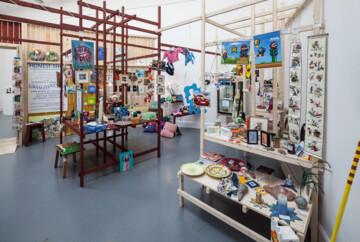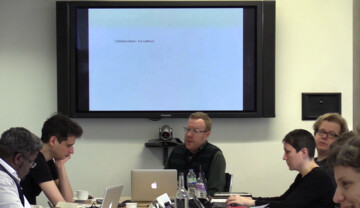Constituencies are fluid, mutable, protean. They grow, change, adapt, hybridise and reform according to circumstance and need. As such constituencies, as well the status of being constituent, are always in the process of both becoming and unbecoming - constituencies result from a process of social production whose medium and the vehicle is, of necessity, collaborative. The etymological root of collaboration (from the late Latin collaborare - meaning co-labour) is crucial here. This notion of collaboration as shared or co-labour, and of labour as a socially produced resource, offers us the means to both re-imagine the kind of work, or labour, that work of art has now become and the role and function that the museum of the future could play within this reimagining. It is the very organic and piecemeal nature of collaboration which allows us to do this. Collaboration is, by its very nature, dialectical. It provides us a tool by which we can re-approach and renegotiate history on behalf of constituency whilst, at the same time, it also allows us a way to think beyond the structural impositions, failed narratives and hierarchical inequalities of democracy today.
For example, in his recent book The Uprising: On Poetry and Finance[1], theorist and activist Franco Berardi argues that the radical deregulation of neoliberal capital is predicated upon the increasing abstraction of language from the body. Deregulatory logic, he suggests, relies on the possibility of endlessly connecting and re-configuring language into regulated, recombinable and meaningless components. This, he argues, runs counter to the open, porous, and poetic use of language as a fluid form of conjunction—as an endlessly open means of understanding ourselves and each other through evolving forms of communication and growth. In the light of this, Berardi proposes that the new job of the artist or poet is to return non-alienated forms of porous, mutable and productive language to the physical and social body. In doing so, and perhaps more importantly, Berardi also allow us to replay the concomitant bifurcation that Marx began to open up at the beginning of Kapital Volume 1 - between an ethical and qualitative valorization of bodily labour (as use-value, as the necessity to produce and reproduce the material means of reproduction) and the abstract, quantitative and instrumentalizing mechanisms of exchange-value.
At first glance, Berardi may seem to be offering us little more here than the possibility of romanticizing the essentialist activity of labour itself (through the act of returning a messy and conjunctive use of language to the body as some kind of ethical rebuff to the dehumanizing consequences of connective, instrumentalized and regulatory capitalism). However, I would argue that just such an insistence on the collaborative production of labour (of labour as a necessary form a social production and reproduction of the means of subsistence, as something which is activated through the very mechanisms of collaboration and constituency) is essential if we are to think and act beyond our current impasse. If this is the case, then collaborative and constituent uses of language would provide us with the means to challenge the established status quo of economic predicates and determinates through the material production of new social meanings and new autonomies.
In turn, it could be argued that the collaborative and constituent production and reproduction of these new social meanings and new autonomies provide us with the only remaining means of escaping the gravity of constituted power (and its concomitant reliance on increasingly interchangeable, centralized, and regulated forms of connectivity). In this scenario, the job of the artist or poet would become the collaborative and constituent work, or co-labour, of keeping language alive, fluid, mutable.
Further to this, such constituent forms of collaboration or co-labour would also imply that art institutions of the future, including museums and galleries, must also begin to radically re-think themselves as collaborations - as simply being co-produced, co-dependent and mutable constituencies amongst others. As such, it would also follow that the collaborative work (or co-labour) of art would no longer be to unite, bridge, or combine the seemingly irreconcilable antinomies of art and life — instead, it would be to operate as a form of collaborative, autonomous and constituent social possibility, or use-value, within an already networked and saturated world of deregulatory and delusory logic.
Reference:
[1] Franco Berardi, ‘After the Future’, AK Press, 2011.



